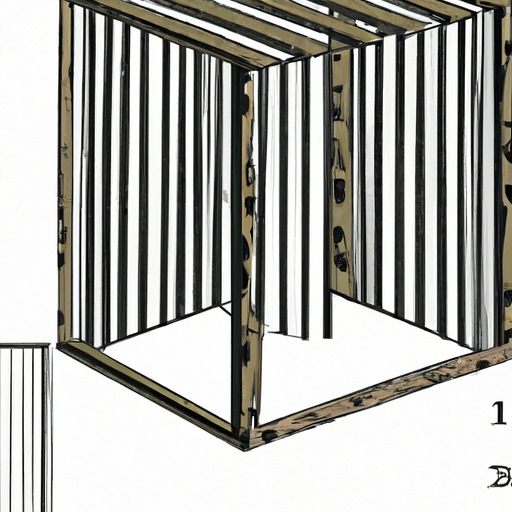If you’re a proud chicken owner worried about sneaky snakes slithering their way into your coop, fear not! This article will provide you with simple and effective methods to reinforce your chicken coop and protect your feathery friends from any unwanted snake intrusions. With these helpful tips and tricks, you’ll be able to sleep soundly knowing that your chickens are safe and secure from these slithery invaders. So, let’s get started and learn how to fortify your chicken coop against potential snake threats!
Inspecting the Chicken Coop
When it comes to protecting your chickens from potential snake intrusions, it is crucial to start by thoroughly inspecting the chicken coop. By identifying potential entry points and examining the structural integrity, you can take the necessary steps to reinforce and secure the coop.
Identifying potential entry points
Begin by closely examining the chicken coop for any potential entry points that snakes could exploit. Look for small gaps, cracks, or holes in the walls, floors, and ceilings. Snakes are incredibly adept at squeezing through even the tiniest openings, so it is essential to be thorough in your inspection. Pay close attention to areas where utility lines enter the coop, as these can create vulnerable points.
Checking for gaps or holes
Once you have identified potential entry points, it is important to assess the condition of any gaps or holes you have found. Determine whether they are large enough for a snake to enter and consider the risk they pose. Even small gaps can be problematic as snakes can stretch or flatten their bodies to fit through tight spaces.
Examining the structural integrity
In addition to identifying potential entry points, it is crucial to examine the overall structural integrity of the chicken coop. Look for any signs of damage or weakness in the walls, roof, and flooring. If there are any areas that appear compromised, make plans to reinforce or repair them. A structurally sound coop will make it much more difficult for snakes to gain access to your chickens.
Removing Attractive Features for Snakes
Snakes are drawn to environments that offer them ample food and shelter, so it is important to eliminate any attractive features that might entice them to enter your chicken coop. By clearing debris and vegetation, securing food sources, and eliminating hiding spots, you can significantly reduce the likelihood of a snake intrusion.
Clearing debris and vegetation
Take the time to regularly clear away any debris or vegetation in and around the chicken coop. Snakes often seek out areas with dense vegetation as it provides them with shelter and makes it easier for them to go unnoticed. By keeping the immediate surroundings of the coop clear, you can minimize potential hiding spots and discourage snakes from approaching.
Securing food sources
Chickens are a source of food for snakes, so it is crucial to secure their food sources to reduce the appeal for potential intruders. Make sure to store chicken feed securely in airtight containers that snakes cannot access. Additionally, ensure that any spills or leftovers are promptly cleaned up to avoid attracting rodents, which in turn can attract snakes.
Eliminating hiding spots
Snakes are skilled at finding hiding spots, so it is vital to minimize their opportunities for concealment around the chicken coop. Trim back any overgrown vegetation that could provide cover for snakes. Remove piles of rocks, logs, or other debris that could serve as hiding spots. By eliminating these hiding spots, you make it harder for snakes to approach your coop undetected.
Installing Snake-Proof Fencing
One of the most effective measures you can take to reinforce your chicken coop against snake intrusions is by installing snake-proof fencing. By selecting appropriate fencing, measuring and marking the perimeter, digging a trench for installation, and securing the fence panels or wires, you can create a strong barrier to keep snakes out.
Choosing appropriate snake-proof fencing
When selecting fencing to keep snakes out of your chicken coop, it is essential to choose a material and design that effectively prevents their entry. Consider options such as 1/4-inch hardware cloth or mesh, as snakes cannot penetrate such small openings. Ensure that the fencing is strong, durable, and resistant to wear and tear.
Measuring and marking the perimeter
Before installing the snake-proof fencing, accurately measure the perimeter of your chicken coop area. It is important to ensure that the fencing extends both above and below ground level to deter snakes from burrowing underneath or climbing over. Use stakes to mark the corners and intervals along the perimeter to guide the installation process.
Digging trench for fence installation
To provide additional protection against burrowing snakes, dig a trench around the perimeter of the chicken coop area. The trench should be approximately 12 inches deep and extend at least 6 inches outward from the coop walls. This depth will prevent snakes from burrowing under the fence and gaining access to your chickens.
Securing the fence panels or wires
Once the trench is prepared, you can start securing the snake-proof fence panels or wires. Attach the fencing material securely to the stakes, ensuring it is taut and flush against the ground. Use zip ties or staples to secure the fencing to the stakes, and bury the bottom portion of the fencing in the trench to discourage snakes from squeezing underneath.
Sealing Gaps and Cracks
To further reinforce the chicken coop against potential snake intrusions, it is crucial to identify and seal any gaps or cracks that could serve as entry points. By using sealants or caulk to close openings and applying weatherstripping to doors and windows, you can create a tighter and more secure environment for your chickens.
Identifying potential gaps and cracks
Thoroughly inspect the chicken coop for any gaps or cracks that may have been missed during the initial inspection. Pay close attention to areas where different materials meet, such as where the walls meet the floor or the roof meets the walls. Snakes can exploit even the smallest openings, so it is important to be meticulous in your examination.
Using sealants or caulk to close openings
Once you have identified gaps or cracks, use appropriate sealants or caulk to close them off. Choose sealants that are resistant to weather and temperature fluctuations, as well as ones that are safe for use in an environment with animals. Apply the sealants generously to ensure a tight seal and prevent snakes from squeezing through.
Applying weatherstripping to doors and windows
Doors and windows are common entry points for snakes, so it is important to address any gaps or spaces around them. Apply weatherstripping to create a tight seal between the doors, windows, and their frames. This additional layer of protection will help prevent snakes from entering through these potential openings.
Implementing a Secure Door System
An essential aspect of reinforcing the chicken coop against potential snake intrusions is implementing a secure door system. By installing self-closing mechanisms, adding door sweeps or thresholds, and ensuring tight-fitting doors, you can significantly reduce the possibility of snakes gaining access to your chickens.
Installing self-closing mechanisms
Installing self-closing mechanisms on the doors of your chicken coop is an effective way to ensure that they are not inadvertently left open, providing an opportunity for snakes to enter. Self-closing hinges or springs will automatically shut the door once it is opened, minimizing the risk of human error and protecting your chickens.
Adding door sweeps or thresholds
To create a tighter seal between the doors and the ground, consider adding door sweeps or thresholds. These attachments will help prevent gaps from forming, reducing the chances of snakes slithering their way inside. Choose door sweeps or thresholds that are durable and can withstand wear and tear.
Ensuring tight-fitting doors
Check that all doors in the chicken coop fit snugly within their frames. If any doors are loose or do not align properly, make the necessary adjustments to ensure a tight fit. Snakes can exploit even the slightest gap, so ensuring that doors are secure and correctly aligned is crucial to keeping them out.
Creating Snake Deterrents
In addition to reinforcing the chicken coop physically, you can implement various snake deterrents to discourage snakes from approaching your chickens. By using snake repellents, planting snake-repellent plants, and installing motion-activated devices, you can create an environment that snakes find unappealing.
Using snake repellents
Snake repellents can be an effective tool in deterring snakes from your chicken coop area. There are various commercially available snake repellent products that you can use according to the manufacturer’s instructions. These repellents typically contain natural ingredients that emit scents that snakes find unpleasant, making them less likely to approach.
Planting snake-repellent plants
Certain plants are known to repel snakes due to their strong aroma or prickly foliage. Consider planting snake-repellent plants around the perimeter of the chicken coop or in other strategic locations. Examples of plants that are believed to deter snakes include marigolds, lemongrass, garlic, and rosemary. These plants not only act as deterrents but also add aesthetic value to your surroundings.
Installing motion-activated devices
Motion-activated devices such as sprinklers or lights can startle and repel snakes, making them an effective deterrent. Set up these devices strategically around the chicken coop area, particularly in areas where snakes are most likely to approach. When a snake triggers the motion sensor, it will activate the device, scaring the snake and discouraging it from returning.
Maintaining a Tidy Environment
Maintaining a tidy environment in and around the chicken coop is not only important for general hygiene but also plays a significant role in reducing the risk of snake intrusions. By regularly cleaning the coop area, clearing eggs and food promptly, and minimizing clutter, you can create an environment that is less appealing to snakes.
Regularly cleaning the coop area
Make it a habit to regularly clean the chicken coop area, removing any debris, waste, or leftover feed. Snakes are attracted to areas with readily available food sources, so keeping the coop clean helps eliminate the temptations that might draw them in. Regular cleaning also reduces the likelihood of attracting rodents that may, in turn, attract snakes.
Clearing eggs and food promptly
In addition to cleaning the coop, it is crucial to clear eggs and food promptly. Leaving eggs or food out for extended periods can attract pests and scavengers, creating a potential food source that might attract snakes. By promptly collecting eggs and removing any uneaten food, you minimize the risk of drawing in unwanted visitors.
Minimizing clutter
Minimize clutter both inside and outside the chicken coop, as clutter provides hiding spots for snakes. Ensure that tools, feed containers, and other items are neatly organized and stored. Regularly inspect the coop area for accumulated clutter and remove any unnecessary items that could provide cover for snakes.
Implementing Traps or Barriers
To further reinforce your efforts in keeping snakes out of the chicken coop, implementing traps or barriers can be an additional line of defense. By using snake traps or glue boards, installing snake barriers or mesh, and diligently checking and emptying traps, you can actively prevent snake intrusions.
Using snake traps or glue boards
Snake traps or glue boards can be an effective method for capturing snakes that have made their way into the chicken coop. These traps typically consist of a sticky surface that ensnares the snake upon contact. Place the traps strategically along potential entry points or areas where snakes have been sighted. Check the traps regularly and safely dispose of any captured snakes.
Installing snake barriers or mesh
In areas where snakes are particularly prevalent, consider installing additional snake barriers or mesh. These barriers can be placed around vulnerable points in the coop, such as gaps in the walls or openings in the roof. Ensure that the barriers are properly secured and cover the entire opening, leaving no gaps for snakes to exploit.
Checking and emptying traps regularly
If you choose to use traps to catch snakes, it is essential to check and empty them regularly. Leaving snakes trapped in the coop for extended periods can lead to stress, injury, or even death. Regularly inspect the traps and safely remove any captured snakes, ensuring they are released away from your property in an appropriate location.
Educating and Observing
To effectively protect your chickens from potential snake intrusions, it is crucial to educate yourself about the local snake species and observe their activity. By learning about their habits, preferred habitats, and potential behaviors, you can better understand how to combat any potential threats. If necessary, seek professional advice or assistance to ensure the safety of your chickens.
Learning about local snake species
Take the time to research and learn about the snake species that are prevalent in your area. Understand their habits, feeding patterns, and potential behaviors. By familiarizing yourself with the local snake population, you can develop strategies and precautions specific to the threats they pose.
Monitoring for snake activity
Regularly monitor the chicken coop area for any signs of snake activity. Look for shed snake skins, tracks, or droppings that might indicate their presence. Be cautious when working around the coop and observe any changes in behavior from your chickens, as they may be an early warning sign of snake activity. By staying vigilant and observant, you can quickly address any potential threats.
Seeking professional advice or assistance
If you are unsure about how to effectively deal with potential snake intrusions or if you have concerns about the safety of your chickens, do not hesitate to seek professional advice or assistance. Local wildlife experts or snake removal services can provide valuable guidance and offer solutions tailored to your specific situation.
Preventing Water Sources
Snakes are attracted to water sources, so it is crucial to prevent water accumulation and regularly check for leaks or drips in and around the chicken coop. By avoiding standing water, using shallow or elevated waterers, and promptly addressing any leaks or drips, you can help reduce the appeal of the coop area for snakes.
Avoiding water accumulation
Regularly inspect the chicken coop and the surrounding area for any signs of water accumulation. Ensure that the coop is properly ventilated and that there are no areas prone to pooling water. Snakes are drawn to moisture, so by eliminating water accumulation, you reduce the likelihood of attracting them.
Using shallow or elevated waterers
When providing water for your chickens, opt for shallow or elevated waterers rather than large bodies of standing water. Snakes are less likely to approach and attempt to access water sources that are not easily accessible to them. Shallow or elevated waterers also minimize the risk of drowning for small birds and chicks.
Regularly checking for leaks or drips
Inspect the chicken coop and its plumbing regularly for any leaks or drips. Correct any issues promptly to prevent water accumulation and reduce the risk of attracting snakes. Routinely check water lines, faucets, and any other sources of water for any signs of leakage. By maintaining a leak-free environment, you create a less appealing environment for snakes.
By following these comprehensive steps to reinforce your chicken coop against potential snake intrusions, you can ensure the safety and well-being of your chickens. Through diligent inspection, regular maintenance, and the strategic implementation of deterrents, barriers, and traps, you can minimize the risk of snake encounters and protect your valuable flock. Remember to stay educated, observe any signs of snake activity, and seek professional advice if needed. With these precautions in place, you can create a secure and snake-free environment for your beloved chickens.




